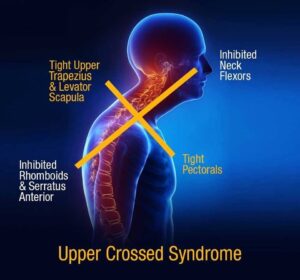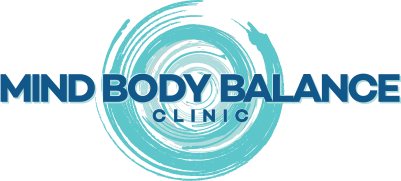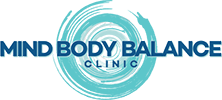
What is the Main Cause of Persistent Neck Pain, Shoulder Pain, and/or Headaches?
Introduction to Upper Crossed Syndrome
Are you one of the millions who suffer from constant neck pain, shoulder pain, or headaches? If so, you might be dealing with something called Upper Crossed Syndrome (UCS). This often-overlooked condition can dramatically affect your quality of life. In this blog post, we’ll explore what UCS is, its causes, and how to manage it effectively. By the end, you’ll have a solid understanding of this syndrome and actionable steps to alleviate your discomfort.
Understanding Upper Crossed Syndrome
First described in 1979, Upper Crossed Syndrome is a predictable pattern of muscle imbalances in the neck and shoulder area. It involves alternating tightness and weakness, creating a crossed pattern when lines are drawn between the affected muscles. This imbalance often leads to chronic pain and can significantly impact your daily activities.
How Sedentary Lifestyles Contribute to UCS
Technological advancements have revolutionized how we work, but they’ve also made us more sedentary. Desk jobs, long hours in front of a screen, and even ride-share and delivery services contribute to prolonged sitting. This inactivity can lead to muscle imbalances, setting the stage for UCS.
Repetitive Labor Work Contribution to UCS
On the flip side, occupations that require repetitive movements, such as factory work or construction, can also contribute to UCS. These types of jobs often involve performing the same tasks repeatedly, leading to overuse and strain on certain muscles.
The Role of Posture in Upper Crossed Syndrome
Poor posture is a significant factor in developing UCS. When you sit hunched over a computer or smartphone, or participate in an occupation with repetitive physical labor, certain muscles become overused and tight, while others become underused and weak. This imbalance creates a cycle of discomfort and pain that can be challenging to break.
Putting it in Perspective
Forward head carriage increases the stress load on the cervical spine and surrounding soft tissues. An example is someone flexing their head 45-60 degrees while looking at their smartphone. This adds 49-60 lbs of pressure onto the cervical spine. The longer one is in the position, the more strain they experience on the associated vertebrae and soft tissue.
What Happens to Your Muscles in UCS
In UCS, specific muscles are prone to tightness, while others are more likely to weaken. The upper trapezius, levator scapula, SCM, and pec major muscles typically become tight. Meanwhile, the rhomboid, serratus anterior, scalenes, and middle & lower trapezius muscles often stretch excessively and weaken. This imbalance leads to a crossed pattern of tight and weak muscles, hence the name “Upper Crossed Syndrome.”
Common Symptoms of Upper Crossed Syndrome
If you’re experiencing any of the following symptoms, UCS might be the culprit:
- Anterior or Forward Head Carriage
- Chronic neck pain
- Elevated and Rounded Shoulders (one or both sides)
- Shoulder pain
- Frequent headaches
- Upper Back pain
- Poor posture
These symptoms can make everyday tasks difficult, affecting both your professional and personal life.
Diagnosing Upper Crossed Syndrome
Diagnosing UCS involves a physical examination and a review of your medical history. A healthcare provider, such as a chiropractor or physical therapist, will assess your posture and muscle imbalances. They may also perform specific tests to identify pain points and muscle weaknesses.
Common Conditions Associated with UCS
UCS can contribute to a variety of other health issues, including:
- Cervical and thoracic joint dysfunction
- Sprain/strains
- Disc degeneration/pain
- Vertigo
- Rotator cuff syndrome
- Thoracic outlet syndrome
- Rib pain
- TMJ/TMD
- Neck pain and nerve impingement
- Headaches
Each of these conditions can exacerbate your symptoms, making it crucial to address UCS early on.
Initial Treatment Options
Initial treatment for UCS should focus on conservative care. This includes joint mobilization and myofascial release techniques like chiropractic adjustments. Soft tissue therapies, such as trigger point therapy and instrument-assisted soft tissue mobilization (IASTM), can also be beneficial.
Stretching and Strengthening Exercises
A comprehensive rehab plan should include stretching tight muscles and strengthening weak ones. Corrective exercises can help restore balance and improve your posture. Regular practice of these exercises can significantly reduce your symptoms.
Improving Your Workstation Ergonomics
One of the most effective ways to manage UCS is to improve your workstation ergonomics. Ensure your chair and computer screen are at the correct height. Consider using a standing desk or a kneeling chair to reduce the strain on your muscles. For more tips on ergonomic furniture, check out this link.
The Importance of Micro-Breaks
Taking micro-breaks throughout the day can help offset the negative effects of prolonged sitting. Set a timer to remind yourself to stand up, stretch, and move around every hour. Even a few minutes of activity can make a big difference.
Nutritional Support for Muscle Health
Certain nutritional supplements can support muscle health and reduce trigger points. Calcium-magnesium complexes, along with joint supplements containing manganese, vitamin C, MSM, chondroitin sulfate, and glucosamine, can be beneficial.
Long-Term Management and Prevention
Managing UCS is an ongoing process. Regular exercise, proper ergonomics, and periodic check-ups with a healthcare provider can help keep your symptoms at bay. Make these practices a part of your daily routine to maintain a healthy, pain-free lifestyle.
Conclusion
Upper Crossed Syndrome is a common but often overlooked condition that can cause significant neck pain, shoulder pain, and headaches. By understanding the causes and symptoms, you can take proactive steps to manage and prevent this condition. Improving your posture, incorporating stretching and strengthening exercises, and optimizing your workstation ergonomics are all crucial. If you’re struggling with UCS, consider consulting a chiropractor or physical therapist for personalized care. Now that you’re aware of this underlying syndrome, take action today to improve your condition and enhance your quality of life.
Would you like to learn more? Book a consultation with Dr. Quintana to get started on your path to better health. Stay tuned for our next blog post, where we’ll continue to explore musculoskeletal imbalances in relation to Lower Crossed Syndrome and how it affects your overall well-being.
GENERAL ENQUIRIES
OFFICE HOURS
| Monday | Closed |
| Tuesday | 9am – 6pm |
| Wednesday | Closed |
| Thursday | 9am – 6pm |
| Friday | 9am – 1pm |
| Saturday | 9am – 1pm |
Social Media Outlets
Request Appointment
Please fill out the form below.


